Sweet bamboo shoot, Taiwan giant bamboo, Dried bamboo shoot
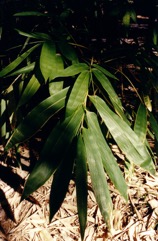
It is cultivated. It occurs in subtropical conditions. It grows up to 1,000 m altitude in Taiwan. It can tolerate temperatures to -4°C. It can also grow in the lowland tropics. It does best on moist fertile soil. Alkaline or acid soils are not suitable for shoots. Melbourne Botanical Gardens. In XTBG Yunnan. In Sichuan.
Also known as:
Bambu taiwan, Big jute bamboo, Gomi, Hava, Kaha, Ma bamboo, Machiku, Ma-chu, Maribob, Wa-bo, Wa-ni
Synonyms
- Bambusa latiflora (Munro) Kurz.
- Bambusa verticillata Willd.
- Sinocalamus latiflorus (Munro) McClure
Edible Portion
- Shoots, Vegetable
Where does Sweet bamboo shoot grow?
Found in: Asia, Australia, China, India, Indochina, Indonesia, Japan, Laos, Malaysia, Myanmar, Northeastern India, Pacific, Philippines, SE Asia, Taiwan, Thailand, United States, Vietnam
Notes: It is also used in medicine. There are about 29 Dendrocalamus species.
Status: It is a commercially cultivated vegetable. The shoots are an important vegetable. It is grown in large quantities in Taiwan and China.
Growing Sweet bamboo shoot, Taiwan giant bamboo, Dried bamboo shoot
Cultivation: Plants can be grown from seed or by rhizome and culm cuttings. Fresh seed germinate in 2 weeks. Culm or stem cuttings 50 cm long with 2 nodes and from 2 year old culms are used. They are planted horizontally 6-10 cm deep. A spacing for shooted cuttings is 4-5 m apart. Harvested shoots are steamed, cut lengthwise, cleaned and sterilised in boiling water for 15 minutes before eating or canning. Shoots are harvested 7-25 days after they emerge.
Edible Uses: The shoots are eaten cooked or canned. They are also shredded and dried. They are also fermented. The shoots are eaten raw. They are also shredded and dried and used in snacks.
Production: A 1-2 year old culm can produce 5-10 shoots. These weigh 3-5 kg.
Nutrition Info
per 100g edible portion| Edible Part | Energy (kcal) | Protein (g) | Iron (mg) | Vitamin A (ug) | Vitamin c (mg) | Zinc (mg) | % Water |
|---|---|---|---|---|---|---|---|
| - | - | - | - | - | - |
Sweet bamboo shoot, Taiwan giant bamboo, Dried bamboo shoot Photos

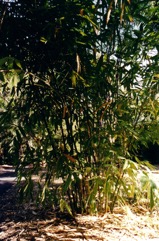
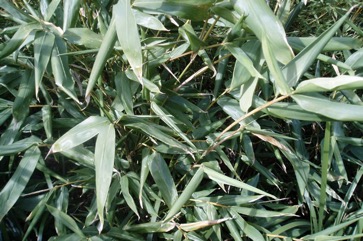
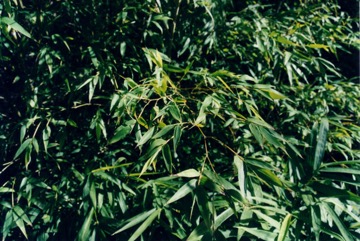
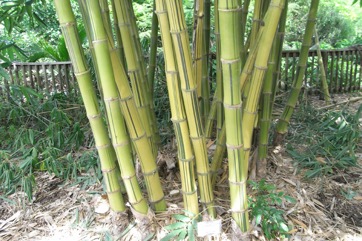
References
Altschul, S.V.R., 1973, Drugs and Foods from Little-known Plants. Notes in Harvard University Herbaria. Harvard Univ. Press. Massachusetts. no. 46 (As Sinocalamus latiflorus)
Anderson, E. F., 1993, Plants and people of the Golden Triangle. Dioscorides Press. p 209
Arora, R. K., 2014, Diversity in Underutilized Plant Species - An Asia-Pacific Perspective. Bioversity International. p 40
Dransfield, S. & Widjaja, EA., 1995, Plant Resources of South East Asia. PROSEA No. 7 Bamboos. Leiden. p 21
Facciola, S., 1998, Cornucopia 2: a Source Book of Edible Plants. Kampong Publications, p 46 (As Sinocalamus latiflorus)
Guite, C., 2016, A study of wild edible plants associated with the Paite tribe of Manipur, India, International Journal of Current Research. Vol. 8, Issue, 11, pp. 40927-40932
Hani Medicine of Xishuangbanna, 1999, p 787
Herklots, (As Sinocalamus latiflorus)
Hibbert, M., 2002, The Aussie Plant Finder 2002, Florilegium. p 84
http://www.plantnames.unimelb.edu.au/sorting/Bamboos_Edible.html
Hu, Shiu-ying, 2005, Food Plants of China. The Chinese University Press. p 288
Kays, S. J., and Dias, J. C. S., 1995, Common Names of Commercially Cultivated Vegetables of the World in 15 languages. Economic Botany, Vol. 49, No. 2, pp. 115-152
Lu, B., et al, 2009, Effects of genetic variability, parts and seasons on the sterol content and composition in bamboo shoots. Food Chemistry 112: 1016-1021
Premlata, T., et al, 2020, Edible bamboo resources of Manipur: consumption pattern of young shoots, processing techniques and their commercial status in the local market. Indian Journal of Traditional Knowledge Vol. 19(1) pp 73-82
Sukarya, D. G., (Ed.) 2013, 3,500 Plant Species of the Botanic Gardens of Indonesia. LIPI p 841
Tanaka, (As Sinocalamus latiflorus)
Trans. Linn. Soc. London 26:152, t. 6. 1868
USDA, ARS, National Genetic Resources Program. Germplasm Resources Information Network - (GRIN). [Online Database] National Germplasm Resources Laboratory, Beltsville, Maryland. Available: www.ars-grin.gov/cgi-bin/npgs/html/econ.pl (10 April 2000)
van Wyk, B., 2005, Food Plants of the World. An illustrated guide. Timber press. p 174 (As Dendrocalamus latifolius ?)
World Checklist of Useful Plant Species 2020. Royal Botanic Gardens, Kew
Yang, R., et al, 2008, Content and distribution of flavonoids among 91 edible plant species. Asia Pac. J. Clin. Nutru. 17(S1): 275-279
Yang Yuming, Wang Kanglin, Pei Shengji, and Hao Jiming, 2004, Bamboo Diversity and Traditional Uses in Yunnan, China Mountain Research and Development, 24(2):157-165. 2004.
Yang, Y., et al, A review of bamboo resources in Yunnan, China www.bioversityinternational.org